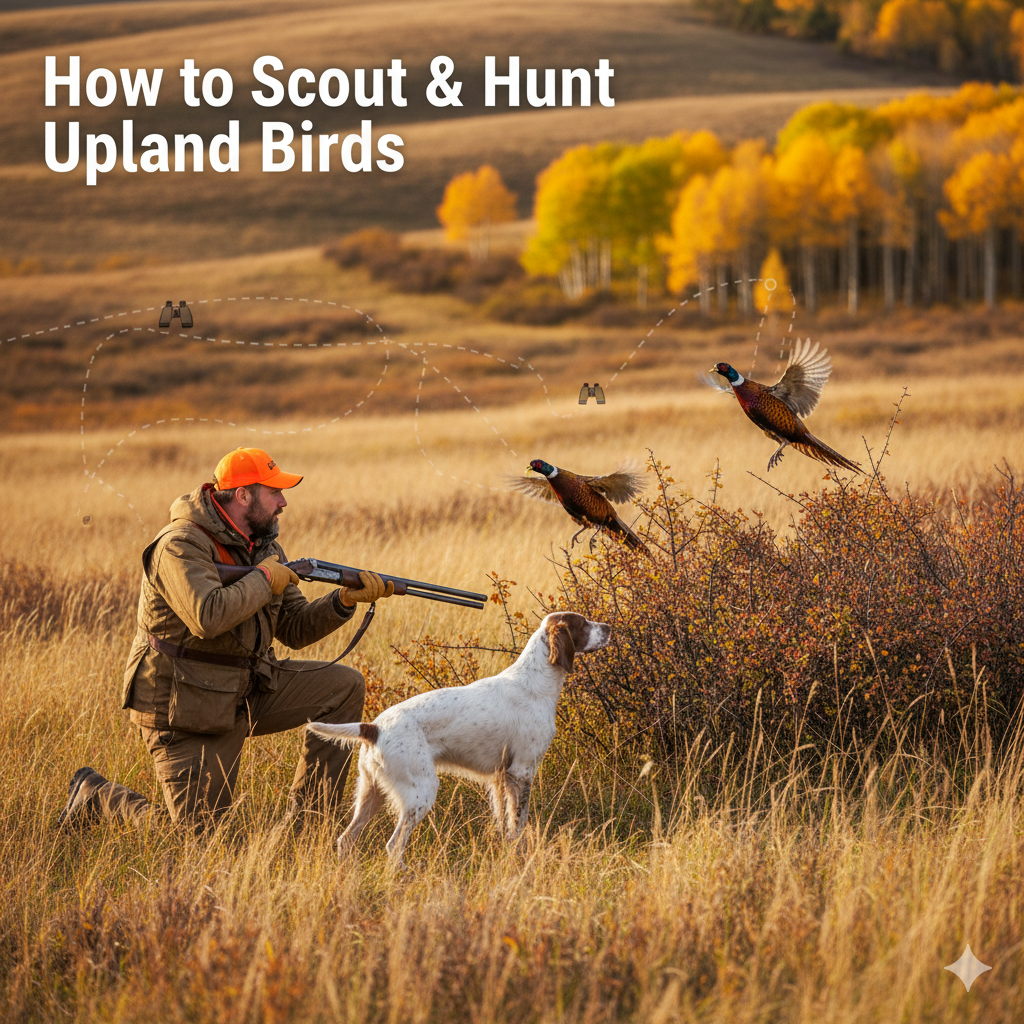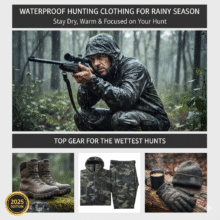How to Scout & Hunt Upland Birds: Pheasant & Quail Guide

Upland bird hunting especially for pheasant and quail is one of the most rewarding pursuits in the field. It combines strategy, habitat knowledge, physical skill, and a keen understanding of bird behavior. Whether you’re chasing early-season quail in brushy cover or late-season roosters in tall CRP grass, success depends heavily on proper scouting, effective hunting tactics, and efficient use of your gear and dog.
In this comprehensive guide, you’ll learn exactly how to scout, locate, pattern, and hunt upland birds like pheasant and quail, plus essential gear tips, dog strategies, and field-tested techniques used by seasoned upland hunters.
1. Understanding Upland Birds: Behavior, Habitat & Daily Patterns
Great upland hunters always start with bird knowledge. Pheasant and quail move predictably throughout the day based on cover, food, temperature, and pressure.
Table of Contents
- 2.1 Scout the Right Habitat
- 2.2 Signs of Bird Activity to Look For
- 2.3 E-Scouting Tools That Work
- 2.4 Timing Your Scouting
- 3.1 Hunt the Edges First
- 3.2 Control the Direction of the Hunt
- 3.3 Work Into the Wind
- 3.4 Slow Down Way Down
- 3.5 Target High-Value Spots
- 4.1 Hunt Covey Edges & Brushy Lines
- 4.2 Know the Covey Flush Pattern
- 4.3 Use a Dog or Go Slow
- 4.4 Shoot Safely on Covey Rise
- 5.1 Best Breeds for Pheasant
- 5.2 Best Breeds for Quail
- 5.3 Dog Hunting Tips
- 6.1 Shotgun Selection
- 6.2 Clothing
- 6.3 Other Useful Items
- 7.1 Early Season
- 7.2 Mid-Season
- 7.3 Late Season
Pheasant Behavior Overview
- Typically run before they fly especially pressured roosters
- Prefer thick, tall cover (CRP, cattails, shelterbelts)
- Feed in mornings/evenings, loaf mid-day
- Roosters often hold tight in cold weather, flush wild in warm weather
- Late season: move to dense thermal cover like cattails and plum thickets
Quail Behavior Overview
- Covey birds usually found in groups of 8–20+
- Hold tight, flush in a burst, then regroup
- Prefer mixed cover brushy edges, fence lines, briars, young timber, grass
- Feed mostly on seeds, bugs, and agricultural leftovers
- After first flush, they often land within 100–300 yards
Understanding these patterns is the foundation of productive scouting.
2. How to Scout Upland Birds Effectively
Scouting is the difference between walking miles blindly and walking into birds confidently. Here’s how to scout like a pro.
2.1 Scout the Right Habitat
Pheasant Habitat Checklist
✔ CRP grasslands
✔ Corn and milo fields (especially harvested edges)
✔ Shelterbelts, windbreak trees
✔ Creek bottoms
✔ Cattail sloughs (late season goldmine)
✔ Brushy fence lines
Quail Habitat Checklist
✔ Mixed grass & brush edges
✔ Hedgerows, briars, plum thickets
✔ Overgrown pastures
✔ Oak scrub flats
✔ Field edges with water sources nearby
✔ Weedy fencerows and abandoned homesteads
These birds require the “holy trinity” of habitat:
Food + Cover + Water.
Anywhere that checks all three boxes is worth scouting.
2.2 Signs of Bird Activity to Look For
When scouting on foot or by binocular:
For Pheasant
- Tracks in mud or snow
- Roosting depressions in grass
- Droppings (white-tipped = pheasant)
- Feathers along trails
- Birds flushing early
- Running trails through CRP
For Quail
- Covey dust bowls
- Small droppings in groups
- Tiny tracks near cover edges
- Feeding scratch marks
- Covey chatter at dawn/dusk
Quail often give themselves away with soft “koi-lee” calls near daylight.
2.3 E-Scouting Tools That Work
Use digital tools before stepping foot in the field:
- OnX Hunt – best for identifying CRP, habitat edges, property boundaries
- Google Earth – great for spotting brushy cover, creek systems, transitions
- State Wildlife Maps – show quail/pheasant harvest hotspots
- Topographic Maps – birds often travel transition lines
Mark promising areas, then confirm by walking or glassing.
2.4 Timing Your Scouting
- Early Morning: Look for feeding birds
- Late Afternoon: Observe movement back to roost
- After Light Snow: Tracks reveal everything
- After Heavy Winds: Birds tuck into sheltered cover
Better scouting = fewer empty miles during the hunt.
3. How to Hunt Pheasant Like an Expert
Pheasants are among the most exciting upland birds to hunt but also the smartest. Here’s how to consistently take roosters.
3.1 Hunt the Edges First
Roosters love transition zones:
- Grass → crops
- Brush → grass
- Shelterbelt → CRP
Walk edges first before diving into thick cover.
3.2 Control the Direction of the Hunt
Pheasants run long before they fly. Block escape routes.
The Ideal Team Strategy
- Blockers stand at the far end of the field
- Walkers push birds toward blockers
- Birds flush within predictable range
If solo, work crosswinds and zig-zag slower than normal to keep birds from running too far ahead.
3.3 Work Into the Wind
A dog needs scent advantage.
- Nose works best with wind in face
- Cuts down on birds escaping behind you
Roosters are notorious for flushing behind hunters who walk with the wind at their backs.
3.4 Slow Down Way Down
Most new hunters walk too fast.
Slow, intentional steps cause pheasants to:
- Hold tighter
- Flush closer
- Avoid running as much
Stop every 20–30 yards; birds often flush when you pause.
3.5 Target High-Value Spots
Experienced hunters always hit:
✔ Corners of fields
✔ Dead-end pockets
✔ Thick cattails (late season)
✔ Willow draws
✔ Abandoned farm structures
These spots concentrate birds under pressure.
4. How to Hunt Quail Like an Expert
Quail hunting is fast, explosive, and requires quick reaction. Here’s how to do it right.
4.1 Hunt Covey Edges & Brushy Lines
Quail almost never sit in wide-open grasslands. Work:
- Brushy hedgerows
- Briar patches
- Thickets
- Creek edges
- Weedy fields
Move slowly, gun ready.
4.2 Know the Covey Flush Pattern
When a covey flushes:
- Birds explode in all directions
- Most land within 200–300 yards
- Singles hold tighter than coveys
After the initial flush, mark the general landing area and go after singles they’re easier to approach.
4.3 Use a Dog or Go Slow
Dogs are a massive advantage for quail:
Pointers hold birds for a clean approach.
Flushers push birds into the air from tight cover.
No dog? Slow down and watch for:
- Rustling in brush
- Soft covey calling
- Birds running before flushing
4.4 Shoot Safely on Covey Rise
Quail burst fast and low. Always ensure:
- No shots below waist height
- Identify your partner’s position
- Avoid shooting toward thick cover where dogs may be
Safety is always first.
5. Bird Dogs for Upland Hunting
While you can hunt upland birds without a dog, nothing matches the effectiveness of a trained bird dog.
5.1 Best Breeds for Pheasant
- German Shorthaired Pointer
- English Setter
- Labrador Retriever
- Springer Spaniel
- Brittany
These breeds excel in dense cover and long days.
5.2 Best Breeds for Quail
- English Pointer
- Setter
- Brittany
- German Shorthaired Pointer
Pointers shine for covey hunting due to strong scent detection.
5.3 Dog Hunting Tips
- Work into the wind
- Keep the dog within shooting range
- Use a bell, beeper, or GPS collar
- Reward steady points and flushes
Your dog’s nose is your greatest scouting tool.
6. Essential Gear for Upland Bird Hunting
You don’t need excessive gear but you need the right gear.
6.1 Shotgun Selection
For pheasant:
- 12 or 20 gauge
- #4, #5, or #6 shot
- Mod or Improved Mod choke
For quail:
- 20 or 28 gauge ideal
- #7.5 or #8 shot
- IC or Skeet choke
6.2 Clothing
Choose durable, briar-resistant clothing:
- Upland vest with game pouch
- Brush pants
- Blaze orange hat/vest
- Waterproof boots with strong ankle support
6.3 Other Useful Items
- GPS app (OnX)
- Knife + game bag
- Dog first-aid kit
- Hand warmers (late season)
- Binoculars
- Water for you AND your dog
7. Seasonal Strategies (Early, Mid, Late Season)
Bird behavior changes drastically through the season.
7.1 Early Season
Birds are:
- Less pressured
- Holding closer
- Often found near food
Target:
- Edges of CRP
- Weedy fencerows
- Grain field borders
Dogs can track easier due to mild temps.
7.2 Mid-Season
Birds start getting smart.
- Roosters run more
- Quail coveys break up earlier
Strategy:
- Walk slower
- Use blockers
- Hunt deeper cover
- Focus on undisturbed land
7.3 Late Season
Cold weather concentrates birds in thick cover.
For pheasant:
- Cattails
- Shelterbelts
- Plum thickets
- Any thermal cover
For quail:
- South-facing hillsides
- Cedars and briars
- Brush draws protected from wind
Late-season hunts reward endurance and persistence.
8. Safety Tips Every Upland Hunter Must Follow
- Identify target AND background
- Keep the muzzle pointed in a safe direction
- Communicate with hunting partners
- Wear blaze orange
- Know dog location at all times
- Never shoot low at quail or pheasant
- Check for private property boundaries
Safety ensures seasons for years to come.
9. Final Tips for Consistent Success
✔ Hunt where other hunters don’t
✔ Be patient slow walking finds more birds
✔ Scout more than you shoot
✔ Learn to read bird tracks and habitat transitions
✔ Trust your dog
✔ Don’t give up after a dry field move to the next habitat edge
Master upland hunting, and every season becomes a new adventure.
Conclusion
Hunting upland birds like pheasant and quail is a blend of art and strategy. When you learn how to scout effectively, read habitat, understand bird behavior, and use the right gear and dog tactics, your success rate increases dramatically.






